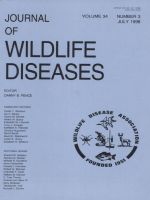Members of the family Columbidae are hosts for the sarcomastigophoran, Trichomonas gallinae, the causative agent of trichomoniasis. Birds of prey are susceptible to the disease when they ingest infected prey. Doves are a major dietary component of urban nesting Cooper's hawks (Accipiter cooperii) in Tucson, Arizona (USA). During the breeding seasons of 1995 and 1996, we clinically evaluated 89 breeding age and 223 nestling Cooper's hawks from urban and exurban (i.e., undeveloped natural area) areas for infection of T. gallinae. There was no difference in the rate of infection between breeding age Cooper's hawks in urban and exurban locations; only one bird tested positive for T. gallinae. However, prevalence of T. gallinae was significantly greater among urban nestlings (85%) than exurban nestlings (9%). There also was a difference between the prevalence in breeding age and nestling Cooper's hawks in urban areas, but not in exurban areas. Trichomonas gallinae was present in at least one nestling at 98% of urban nests tested (n = 51), but only 13% of exurban nests tested (n = 23). The patterns we found probably are caused by three factors; doves are hosts for the parasite, they are present in large numbers in Tucson, and they are the primary prey of urban Cooper's hawks at that locality.
How to translate text using browser tools
1 July 1998
TRICHOMONIASIS IN COOPER'S HAWKS FROM ARIZONA
Client W. Boal,
R. William Mannan,
K. Stormy Hudelson

Journal of Wildlife Diseases
Vol. 34 • No. 3
July 1998
Vol. 34 • No. 3
July 1998
Accipiter cooperii
Cooper's Hawk
Trichomonas gallinae
trichomoniasis
urban wildlife




